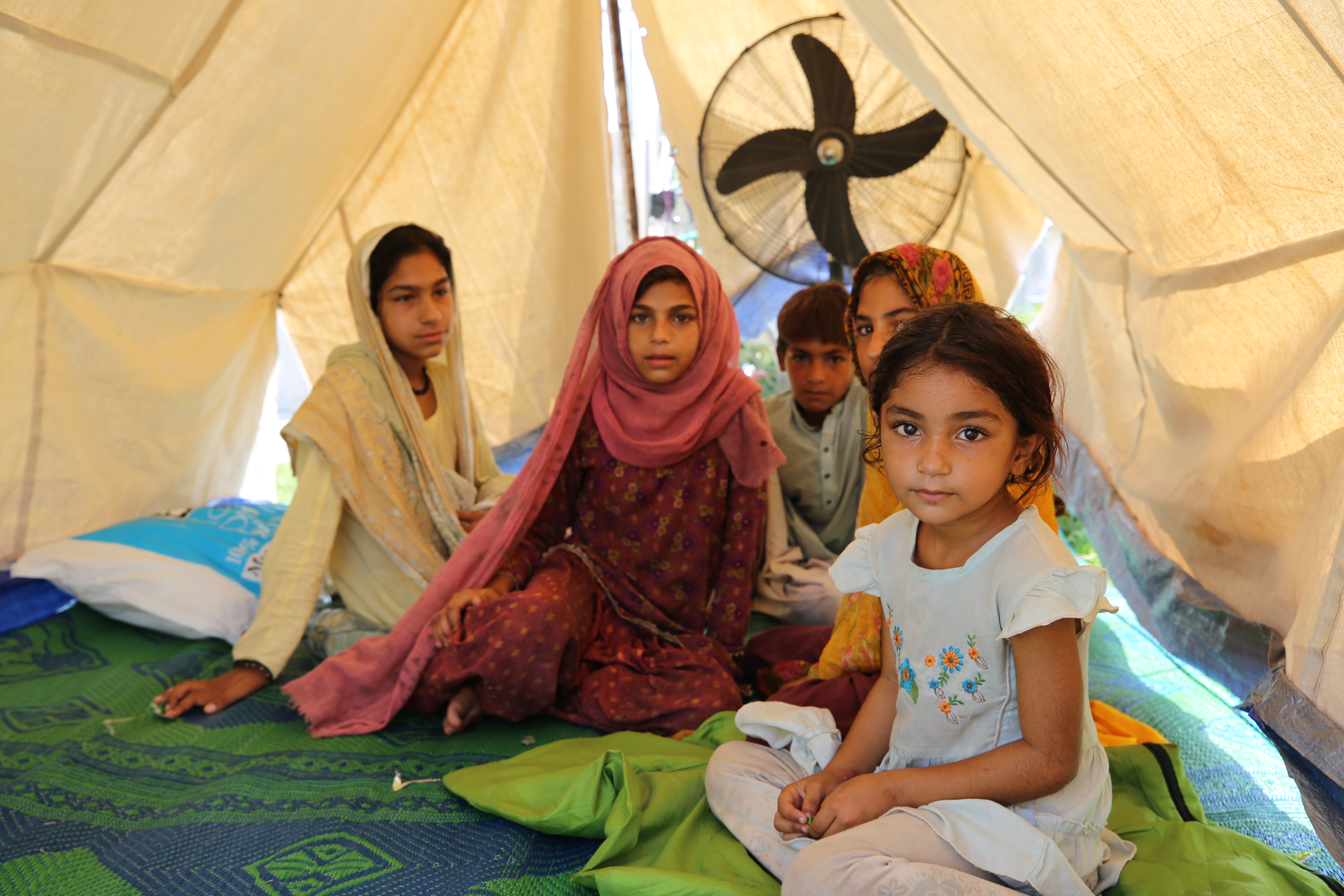Urgent action needed for those pushed from homes due to climate, conflict and crisis
Humanitarian aid alone cannot overcome record levels of internal displacement
November 29, 2022

Children in a camp in Balochistan, displaced by unprecedented floods in Pakistan
(Geneva, 29 Nov) — In 2022, the number of people forced to flee from their homes crossed 100 million. The majority of those people displaced by conflict, violence or disasters are trapped within their own countries, often for years or decades. Yet, internally displaced persons (IDPs) are rarely in the headlines. This invisible crisis is due to gaps in development support, says the United Nations Development Programme (UNDP).
A new UNDP report, Turning the tide on internal displacement: A development approach to solutions, argues that longer-term development action is needed to reverse record levels of internal displacement, with millions more people predicted to be uprooted by climate change. By 2050, climate change could force more than an estimated 216 million people to evacuate their homes, leaving their present lives and livelihoods behind, and move to safer areas.
At the end of 2021, there were 59.1 million people forcibly displaced within their own countries. They are struggling to cover their basic needs, find decent work, have a stable source of income, be healthy or send their children to school. Women, children and other marginalized groups are suffering the most. As the 2022 Secretary-General’s Action Agenda on Internal Displacement says, the current situation is untenable.
“More efforts are needed to end the marginalization of IDPs who must be able to exercise their full rights as citizens including through access to vital services such as healthcare, education, social protection and job opportunities,” says UNDP Administrator, Achim Steiner. “In tandem with critical humanitarian assistance, this stronger development-focused approach will be vital to set the conditions for pathways to lasting peace, stability and recovery.”
Analysis of sample data provided by the Internal Displacement Monitoring Centre (IDMC) from Colombia, Ethiopia, Indonesia, Nepal, Nigeria, Papua New Guinea, Somalia and Vanuatu shows that a third of those people surveyed who were internally displaced fell into unemployment. 68 percent say they don’t have enough money to meet their households’ needs and a third say their health has worsened since they fled from home.
Ensuring the rights and needs of IDPs are met by their governments is a perquisite to achieving the Sustainable Development Goals, agreed by world leaders in 2015 with a fast-approaching deadline.
The report highlights that overcoming internal displacement depends on governments implementing key development solutions, including ensuring equal access to rights and basic services, promoting socio-economic integration, restoring security and building social cohesion.
It is imperative to bring this invisible crisis onto the international agenda. The report calls for better data and research. UNDP is committed to bridging this gap with a Solutions to Internal Displacement Index to monitor progress and to help governments shift from humanitarian to development responses.
Check the full report here.
For more information, contact:
In Geneva and London: Sarah Bel - sarah.bel@undp.org / Patrick Nicholson - patrick.nicholson@undp.org
In New York City: Aimee Brown - aimee.brown@undp.org / Guilherme Larsen - guilherme.larsen@undp.org
Note to Editors:
The global number of people forced to flee due to persecution, conflict, violence, human rights violations and events seriously disturbing public order had reached more than 100 million for the first time on record, according to UNHCR.
The number of internally displaced persons (IDPs) around the world was at 59.1 million people by the end of 2021, according to IDMC. Since then, some 6.2 million people have been displaced internally within Ukraine according to UNHCR.
By 2050, climate change could force more than 216 million people to move within their own countries according to the World Bank.
The analysis in the Turning the Tide report is of data collected by IDMC between January 2021 and January 2022 from 2,653 internally displaced individuals and people from within the host communities across Colombia, Ethiopia, Indonesia, Nepal, Nigeria, Papua New Guinea, Somalia and Vanuatu.
While effort was made for the sample to be representative, the representativeness does not capture the entire population of IDPs or hosts in each country. And the eight selected countries do not reflect the reality of IDPs in other countries affected by internal displacement.
Compared to members of the host communities, IDPs were, on average, 14% less likely to have at least one household member employed at the time of survey and 12% more likely to have experienced a physical health decline. IDPs who report poorer health care access in their new location are especially prone to a fall in health.
Children who are internally displaced are on average 28% more likely than host children to have stopped going to school at some point and an internally displaced girl who experienced breaks in education have the lowest attendance of all children at time of survey.
Displaced women are much less likely to find work and stay healthy than those from similar backgrounds in host communities, according to the surveys.

 Locations
Locations


